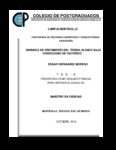| dc.contributor.author | Hernández Moreno, Edgar. | |
| dc.creator | HERNANDEZ MORENO, EDGAR; 442069 | |
| dc.date.accessioned | 2014-12-16T15:24:36Z | |
| dc.date.available | 2014-12-16T15:24:36Z | |
| dc.date.issued | 2014 | |
| dc.identifier.uri | http://hdl.handle.net/10521/2475 | |
| dc.description | Tesis (Maestría en Ciencias, especialista en Ganadería).- Colegio de Postgraduados, 2014. | es_MX |
| dc.description.abstract | Con el objetivo de estudiar la distribución estacional del trébol blanco (Trifolium repens L.) se realizó un análisis de crecimiento estacional en Montecillo, Texcoco, Estado de México. En praderas con dos años de establecidas, se trazaron 24 parcelas y se distribuyeron aleatoriamente en ocho tratamientos con tres repeticiones. Semanalmente se cosecharon tres parcelas para evaluar las siguientes variables: acumulación de materia seca, tasa de crecimiento del cultivo, composición botánica y morfológica, índice de área foliar y altura de la pradera. La mayor cantidad de forraje (P<0.05) se presenta en la octava semana de primavera y otoño, séptima en verano y en invierno hacia la sexta semana se acumularon 1420 kg MS ha-1. La hoja del trébol constituyó el principal componente del forraje excepto en verano. Los resultados sugieren que el pastoreo debe realizarse en la semana 7, 6, 7 y 5 para primavera, verano, otoño e invierno, cuando se ha alcanzado el mayor rendimiento de hoja. Adicionalmente se evaluó el efecto de tres frecuencias de pastoreo (cada 28 días en primavera verano y cada 35 días, 95 y 100% de RI, en otoño e invierno, 95 y 100% de radiación interceptada) sobre el comportamiento productivo del trébol blanco (Trifolium repens L.) en asociación con pasto ovillo (Dactyis gomerata L.). Los tratamientos se distribuyeron aleatoriamente en un diseño de bloques al azar con 3 repeticiones. Las variables evaluadas fueron: acumulación de materia seca, composición botánica y morfológica, índice de área foliar, tasa de crecimiento y altura de la pradera. Solo se encontraron diferencias significativas (P<0.05) de los tratamientos para el invierno, cuando el pastoreo al 95% de RI fue mayor en 50 % al tratamiento con 100% RI y en 42% al de 35 días La frecuencia de pastoreo no afecto el rendimiento de la pradera, excepto en invierno donde el mejor rendimiento se obtuvo al pastorear al 95% de RI. _______________ GROWTH DYNAMIC OF WHITE CLOVER UNDER GRAZING. ABSTRACT: In order to study the seasonal growth curve of white clover (Trifolium repens L.) a growth analysis was carried out in Montecillo, Texcoco, Estate of México. In two years old sward, 24 plots were stablished and allocated randomly in eight treatments and three replications. Every week three plots were cut to evaluate the following variables: cumulative herbage mass, growth rate, botanical and morphological composition, leaf area index and sward height. The highest cumulative herbage mass (P<0.05) was found at the eight weeks of regrowth in spring and autumn, seven in summer and six weeks in winter. The leaf clover constituted the main component of herbage mass, except in summer. Results suggest that grazing should be done in week 7, 6, 7, and 5 for spring, summer, autumn and winter, when it has reached the highest leaf mass yield. In addition it was evaluated the effect of three grazing frequencies (every 28 days during spring and summer and every 35 days in fall and winter, 95 and 100% of light interception) on the productive performance of white clover (Trifolium repens L.) associated with orchard grass (Dactyis gomerata L.). Treatments were allocated randomly with three replications. The evaluated variables were: cumulative herbage mass, growth rate, botanical and morphological composition, leaf area index and sward height. Only significant differences (P <0.05) were found in winter, when treatment at 95% LI was 50% higher to 100% LI and 42% to 35 days. The grazing frequency did not affect herbage yield, except in winter when the best performance was obtained by grazing at 95% of LI. | es_MX |
| dc.description.sponsorship | Consejo Nacional de Ciencia y Tecnología (CONACyT). | es_MX |
| dc.language.iso | spa | es_MX |
| dc.rights.uri | http://creativecommons.org/licenses/by-nc-nd/4.0 | |
| dc.subject | Trifolium repens L. | es_MX |
| dc.subject | Análisis de crecimiento | es_MX |
| dc.subject | Frecuencia de pastoreo | es_MX |
| dc.subject | Acumulación de materia seca | es_MX |
| dc.subject | Tasa de crecimiento | es_MX |
| dc.subject | Growth analysis | es_MX |
| dc.subject | Grazing frequency | es_MX |
| dc.subject | Cumulative herbage mass | es_MX |
| dc.subject | Growth rate | es_MX |
| dc.subject | Ganadería | es_MX |
| dc.subject | Maestría | es_MX |
| dc.title | Dinámica de crecimiento del trébol blanco bajo condiciones de pastoreo | es_MX |
| dc.type | Artículo | es_MX |
| Tesis.contributor.advisor | Guerrero Rodríguez, Juan de Dios. | |
| Tesis.contributor.advisor | Hernández Garay, Alfonso. | |
| Tesis.contributor.advisor | Martínez Hernández, Pedro Arturo. | |
| Tesis.contributor.advisor | Quero Carrillo, Adrián Raymundo. | |
| Tesis.date.submitted | 2014 | |
| Tesis.date.accesioned | 41983 | |
| Tesis.date.available | 41984 | |
| Tesis.format.mimetype | pdf | es_MX |
| Tesis.format.extent | 1,377 KB | es_MX |
| Tesis.subject.nal | Rendimiento del forraje | es_MX |
| Tesis.subject.nal | Forage yield | es_MX |
| Tesis.subject.nal | Factores ambientales | es_MX |
| Tesis.subject.nal | Environmental factors | es_MX |
| Tesis.subject.nal | Montecillo, Texcoco, Estado de México, México | es_MX |
| Tesis.rights | Acceso abierto | es_MX |
| Articulos.subject.classification | Trébol blanco | es_MX |
| dc.type.conacyt | masterThesis | |
| dc.identificator | 6 | |
| dc.contributor.director | GUERRERO RODRIGUEZ, JUAN DE DIOS; 35264 | |


